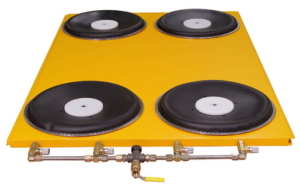Within different sectors, grouped as transportation, manufacturing, military and defense, shipping, spacecraft, automobile, and so on, you’ll likely find actuators playing a crucial role. They control and facilitate virtually every mechanized process within a facility.
Actuators are mechanical devices responsible for converting energy into motion. Mechanical, hydraulic, and mechanical or electrical actuators are some of the most commonly used ones for operating industrial lift tables. Once you understand the available types and their usage, you can make an informed decision regarding the type that’s right for your application and environment.
Mechanical or Electric
Mechanical actuation-based lifts are known for high-precision levels, making them suitable for conveyor systems or automated equipment integrations where repeatability is key. They’re driven by electric systems to provide stable load support throughout the lift’s travel.
Many programmable options are available today, allowing lift tables to be sent or called to multiple predetermined levels. This is a critical asset for precision and alignment applications. Mechanical lifts are precise, fast, and suitable for sensitive environments where there’s a need for averting hydraulic fluid leak risks.
However, they are fairly expensive and often have complicated designs that can lead to a higher risk of downtime and breakdown. Plus, you can’t get the same amount of power and strength with electrics that you can with pneumatics or hydraulics.
Hydraulic
Versatility is the primary reason behind the popularity of hydraulic lift tables. These actuators work by creating a pressurized hydraulic liquid in the cylinders to lower and raise the lift. They are suited for various applications, from parts assembly to heavy equipment handling plus ergonomic work positioning.
The heavy-duty lift tables are efficient, convenient, and powerful. They’re safe, easy to control, portable, and economical. They are ideally suited for heavy equipment applications.
While there are numerous benefits of hydraulic actuated lifts, if you’re looking for repeatability, precise positing, and longevity, this type of lift experiences plenty of drifting, and so it isn’t the best solution in this situation.
Pneumatic
Pneumatic tools are driven by heavy-duty, direct-acting industrial airbag actuators. They’re an incredibly dependable and economical solution for stacking, transferring, and shuttling goods or materials over short travels. These actuators are ideal for clean classroom applications, where contamination avoidance is critical.
Pneumatic equipment provides safe lifting solutions for operations in environmentally-sensitive or explosion-proof locations where standard electrical equipment isn’t allowed, or there can’t be a risk of hydraulic leakage. These high-speed devices are relatively less expensive and use compressed air for converting energy.
The increased duty cycling allows for improved productivity, which leads to higher ROI and profitability. Moreover, pneumatic systems are simpler to operate and easy to maintain or repair if anything goes wrong.
The Hovair System Difference
The type of actuation you need largely depends on the requirements of your application, industry, and environment. If you need help deciding, our experts are just a call away!
Hovair Systems will help you streamline the right lift table that will provide you reap maximum benefits from your investment with greater safety, productivity, and equipment longevity.
Our experts can also guide you regarding lifting & rigging equipment, air bearings, industrial turntable systems, air caster, air beams, heavy load carriers, air compressor tools, paper roll handling technology, automated guided vehicles, automobile turntables, commercial turntables, and other heavy load management devices, and weight management solutions.
Connect with us to learn more about our top-quality heavy load handling systems.

